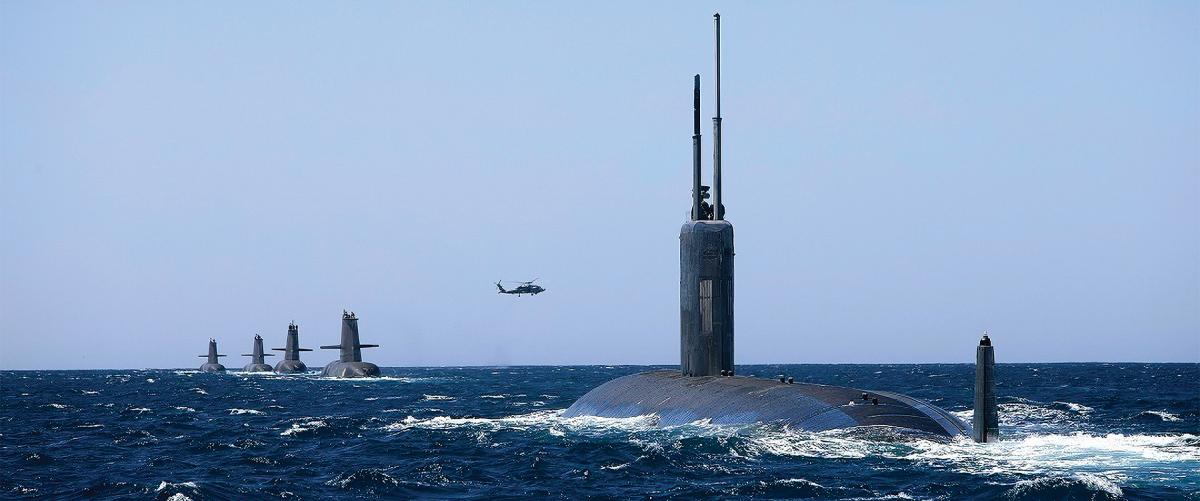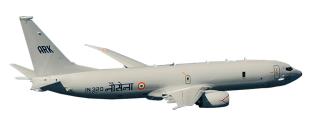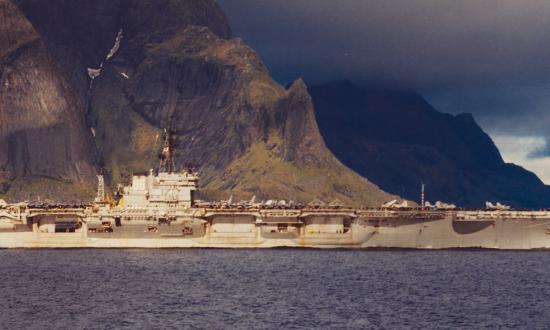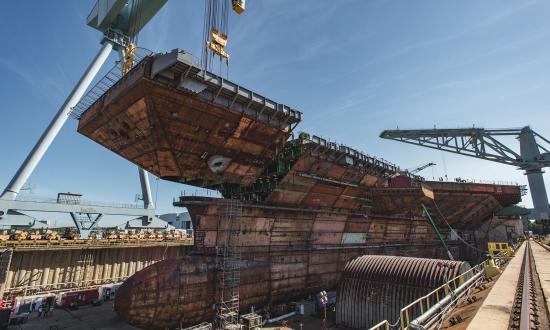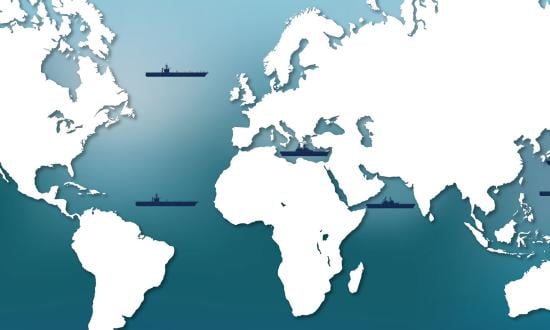Two important maritime developments in 2021 will influence events in the Indian Ocean for quite some time. The first was the tripartite defense agreement among Australia, the United Kingdom, and the United States (AUKUS) announced in September with a suddenness that took everyone—except a tight group of negotiators—by surprise. The agreement covers several areas of technology hardware and cooperation. It rocked the boat, however, because its main thrust was to help Australia buy and/or build nuclear-powered attack submarines (SSNs). Canberra had for years ruled nuclear-powered submarines out, until suddenly ruling them in.1 There is some irony in Australia choosing to switch to nuclear-powered submarines after canceling the French-designed diesel submarines (SSKs) based on an SSN design. France—an Indian and Pacific Ocean nation because of its colonial holdings—was very upset about the AUKUS agreement.
Also in September, the second development was some purposeful progress in the Quadrilateral Security Dialogue—the Quad—with the leaders of India, Australia, Japan, and the United States meeting for the first summit. Disappointingly, the official statements skirted naming China as the clear concern that it is.2 The Quad has had a difficult road to this stage, and its evolution “from Quad to squad” to build coherent and cooperative deterrent capabilities vis-a-vis China remains elusive.3 While at their leading edges both AUKUS and the Quad share maritime concerns and responses, the new trilateral group could provide a measure of hard power that, under the growing challenges of China’s heavily armed antiaccess/area-denial network and SSNs, could significantly add to a coalition naval toolkit. However, the added muscle for the Australian Navy seems many years away. This makes the need for the Quad to evolve more urgent.
The Quad should move toward enhancing its hard power in multidimensional warfare areas even as it enables other initiatives. Despite the Quad not mentioning China in the joint statement, there are reasons for optimism that its muscle may be pumped up in the future. The communiqué leaves the door open, saying, “We also recognize that our shared futures will be written in the Indo-Pacific, and we will redouble our efforts to ensure that the Quad is a force for regional peace, stability, security, and prosperity [emphasis added].”4 Certainly, if the current Ukraine-Russia conflict points to anything, it is the need for greater consolidation in partnerships and multidimensional military cooperation in the Indo-Pacific. Reaching such a stage will require the four national leaders and governments to see the Quad differently. Until then, the circumspection that naval leaders showed at a February 2022 gathering of navies at Visakhapatnam, India—saying the Quad is a diplomatic construct—is understandable, if unhelpful.5
In the maritime realm, China continues its consolidation in the Indian Ocean region with hardware cooperation, exercises, and the quest for places and bases. Its partnerships among what has been called the “other Quad” (China, Iran, Pakistan, and Russia) are deepening.6 In time, this could be a geopolitical concern, although the absence of binding values could remain a bugbear. In contrast, the primary Quad of maritime democracies is bound by the caulk of respect for a rules-based global order, internal governance values, and enduring democratic systems.
Major multinational naval exercises continued to be of note in 2021. The Malabar series was again conducted in two editions, one in the Philippine Sea in August and another in the Bay of Bengal during October, improving the operational cooperation of the Quad members under the decades-old Malabar label.
In the Arabian Sea, the Pakistan Navy hosted the biennial Exercise Aman, which was built on a variety of older and emerging relationships. In February, 45 navies—some with ships and others via delegations—showed up for the seventh iteration of the exercise, including ships from the U.S. and Russian navies.7
At sea, a relatively recent problem has worsened. In the western parts of the Indian Ocean, coalition forces, individual navies, and coast guards made record seizures of pirates, smugglers, and vessels engaged in illegal, unreported, and unregulated (IUU) fishing in 2021.8 On the surface, these are worrying statistics about the potential scale and possible political and social consequences within several countries, especially regarding terror financing and the cost of preventive patrolling. The good news is that there is greater intelligence sharing, and initiatives such as the United Nations’ Southern Route Partnership and Indian Ocean Forum on Maritime Crime are gaining traction.
Beneath the surface, there are two aspects to consider. One is the rise in IUU fishing, once called “poaching.” The Africa Defense Forum notes that “China, home to the world’s largest fishing fleet, is also the world’s worst violator, according to the IUU fishing index.”9 China’s distant-water fleet quite literally spreads its nets far and wide, in the process contributing to global food insecurity and environmental and climate change challenges.
There are other subsurface concerns. First, China’s SSN and SSK numbers are growing, as is that country’s ability to deploy across the Indian Ocean. This growing submarine fleet could—and likely will—be complemented by unmanned vehicles with capabilities beyond intelligence and data collection. Second, current and future proliferation of Chinese submarines through sale or lease only adds to others’ concerns. Thailand is a customer (though it faces obstacles because the deal stipulated use of German diesel engines, which have been blocked by a European Union arms embargo in place since 1989).10 Of the eight air-independent propulsion (AIP) Type 039A/Yuan-class submarines Pakistan is acquiring (four from Chinese yards, four to be license-built), steel was cut for the fifth, the Hangor, at Karachi in December.
Meanwhile, the Indian Navy inducted more P-8I Poseidon maritime patrol aircraft. And the service’s project to acquire six submarines based on the Franco-Spanish Scorpène design is slowly coming to completion, albeit without AIP. With the contract for 24 U.S. MH-60R helicopters, the Indian Navy is gradually rebuilding its antisubmarine warfare capabilities. This could be an area for greater intellectual, technological, and operational cooperation within the Quad navies spanning underwater domain awareness as well.
Jakarta, Manila, and Kuala Lumpur’s concerns about China have not abated. The contract for India to sell Brahmos antiship missile batteries to the Philippines should be a tactical boost, but it also reinforces strategically important deterrent messages to China that India can assist ASEAN nations bilaterally. Continuing the reforms reported in last year’s Proceedings international navies issue, the pivotal state of Indonesia continued its organizational reforms, including creating a joint military command and subordinate fleet commands.11 While Indonesia has reservations about multilateral partnerships, it has grown its bilateral activities robustly with many countries, including the Quad fraternity.
It may be fair—if not surprising—to observe that the complexities of international relations seen on land have analogous effects in the maritime world. The advantage in the oceanic domain is that cooperation not only is more feasible and acceptable, but also has consequent effects in friendly and adversarial capitals. That is what sea power does, and what nations ought to keep striving for.
1. RADM Sudarshan Shrikhande, IN (Ret.), “Australia-India: Alliances and Self-Reliance,” Australian Naval Institute, 3 October 2021.
2. India Ministry of External Affairs, “Joint Statement from Quad Leaders,” 24 September 2021.
3. RADM Sudarshan Shrikhande, IN (Ret.), “For a Secure Indo-Pacific, Grow the Quad,” U.S. Naval Institute Proceedings 146, no. 8 (August 2020): 41–42.
4. India Ministry of External Affairs, “Joint Statement.”
5. Dinakar Peri, “Quad Grouping a Diplomatic Arrangement Says Visiting U.S. Admiral,” The Hindu (India), 28 February 2022.
6. Owigwe Eguegu and Javayirah Kultum Aatif, “Iran’s Membership Raises the SCO’s Profile and Expectations,” The Diplomat, 21 September 2021.
7. The Pakistan Navy, “Multinational Maritime Exercise Aman-21,” Navy News, March 2021.
8. Combined Maritime Forces, “CTF150 Seizes Record Amount of Illegal Drugs in 2021,” 9 December 2021.
9. ADF Magazine Staff, “Illegal Fishing Emerges as Africa’s Main Maritime Security Threat,” Africa Defense Forum, 5 January 2022.
10. Niharika Mandana, “China Is Selling Thailand a Submarine: The Problem Is No Engines,” The Wall Street Journal, 14 March 2021.
11. “Chief of Naval Staff Inaugurates the Establishment of the Indonesian Military Command,” VOI News (Indonesia), 3 February 2022.



